Nudity
Nudity is a state of being in which a human is not wearing clothing or specifically is not covering the genitals.[1] In some societies, partial nudity is defined as not covering other parts of the body that are deemed to be sexual.
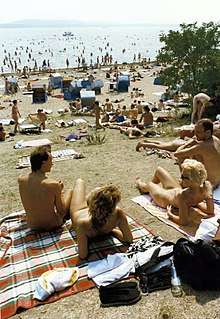
Nakedness, or the loss of body fur, was one of the physical characteristics that marked the evolution of anatomically modern humans from their hominini ancestors. For many thousands of years, humans wore no clothing, which continues to be the norm in some isolated indigenous societies in tropical climates. It is generally accepted that the widespread adoption of clothing occurred as people migrated to other climates which required protection from the elements. In addition, as societies developed from being hunter-gatherers to being agrarian, clothing became part of cultural evolution as individuals and groups became differentiated by status and class. In early civilizations such as Egypt, slaves, children, and others with lower status often continued to be naked.
The modern understanding of nudity is culturally complex due to different meanings given various states of undress in differing social situations. In any particular society, nudity is defined in relation to being properly dressed, not in relation to the specific body parts being exposed. For humans, nakedness and clothing are connected to many cultural categories such as identity, privacy, social status and moral behavior.[2] Synonyms and euphemisms for nudity abound, including "birthday suit", "in the altogether" and "in the buff". "In a state of nature" is also used by philosophers to refer to the state of humans before the existence of organized societies.[3]
In Western societies, there are two cultural traditions relating to nudity in various contexts. The first tradition comes from the ancient Greeks, who saw the naked body as the natural state and as essentially positive. The second is based upon the Abrahamic religions—Judaism, Christianity, and Islam—which have viewed being naked as shameful and essentially negative. The interaction between these traditions has resulted in Western ambivalence toward nudity. While public nudity remains limited in most situations, in America nudity is more likely to be seen sexually, while in much of Europe, there is more openness to non-sexual nudity in recreation and daily life. In Africa, there is a sharp contrast between the attitude toward nudity in Islamic countries and the attitude toward nudity in certain sub-Saharan countries that never abandoned, or are reasserting, precolonial norms. In Asia, the norms regarding public nudity are in keeping with the cultural values of social propriety and human dignity. Rather than being perceived as immoral or shameful, nakedness is perceived as a breach of etiquette and perhaps as an embarrassment.
Societies use clothing (or the lack thereof) as a marker of social status. Generally, social norms regarding nudity are different for men than they are for women. It was not until the 17th century in Europe that the female breast became a part of the body that must be covered in public. It is only in the modern era that the nudity of children represented anything but innocence. Individuals may intentionally violate norms regarding nudity; those without power may use nudity as a form of protest, and those with power may impose nakedness on others as a form of punishment.
History
The history of nudity involves social attitudes to nakedness of the human body in different cultures in history. The use of clothing is one of the changes that mark the end of the Neolithic and the beginning of civilization.
Prehistory
Evolution of hairlessness
The dissipation of body heat remains the most widely accepted evolutionary explanation for the loss of body hair in early members of the genus homo, the surviving member of which is modern humans.[4][5][6] Less hair, and an increase in sweat glands, made it easier for their bodies to cool when they moved from shady forest to open savanna. This change in environment also resulted in a change in diet, from largely vegetarian to hunting. Pursuing game on the savanna also increased the need for regulation of body heat.[7] Anthropologist and palaeobiologist Nina Jablonski posits that the ability to dissipate excess body heat through eccrine sweating helped make possible the dramatic enlargement of the brain, the most temperature-sensitive human organ.[8] Thus the loss of fur was also a factor in further adaptations, both physical and behavioral, that differentiated humans from other primates. Some of these changes are thought to be the result of sexual selection, which was first proposed by Darwin in The Descent of Man, and Selection in Relation to Sex. By selecting more hairless mates, humans accelerated changes initiated by natural selection. Sexual selection may also account for the remaining human hair in the pubic area and armpits, which are sites for pheromones, while hair on the head continued to provide protection from the sun.[9]
A divergent explanation of humans' relative hairlessness holds that ecroparasites (such as ticks) residing in fur became problematic as humans became hunters living in larger groups with a "home base". Nakedness would also make the lack of parasites apparent to prospective mates.[10]
The last common ancestor of humans and chimpanzees was only partially bipedal, often using their front legs for locomotion. Other primate mothers do not need to carry their young because there is fur for them to cling to, but the loss of fur encouraged full bipedalism, allowing the mothers to carry their babies with one or both hands. The combination of hairlessness and upright posture may also explain the enlargement of the female breasts as a sexual signal.[6]
With the loss of fur, darker, high-melanin skin evolved as a protection from ultraviolet radiation damage. As humans migrated outside of the tropics, varying degrees of depigmentation evolved in order to permit UVB-induced synthesis of previtamin D3.[11][12]
Origin of clothing
The wearing of clothing is most likely a behavioral adaptation arising from the need for protection from the elements, including the sun (for depigmented human populations) and cold temperatures as humans migrated to colder regions. According to a 2010 study published in Molecular Biology and Evolution, estimates of the origins of clothing are based upon a genetic analysis indicating that clothing lice diverged from head louse ancestors at some point in time between 83,000 years ago and 170,000 years ago. This information suggests that the use of clothing likely originated with anatomically modern humans in Africa prior to their migration to colder climates.[13] A 2017 study published in Science estimated that anatomically modern humans evolved 260,000 to 350,000 years ago.[14]
The complex garments needed for survival in extreme cold would have required invention of the tools for turning animal skins into clothes: scrapers for cleaning and smoothing, fine stone knives for cutting and bone needles for stitching.[15] What is now called clothing may have originated along with other types of adornment, including jewelry, body paint, tattoos, and other body modifications, "dressing" the naked body without concealing it.[16] According to Leary and Buttermore, body adornment is one of the changes that occurred in the late Paleolithic (40,000 to 60,000 years ago) in which humans became not only anatomically modern, but also culturally and psychologically modern and capable of self-reflection and symbolic interaction.[17]
Ancient history
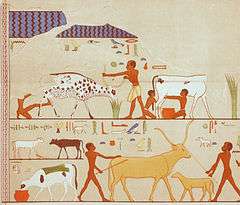
In ancient Mesopotamia, most people owned a single item of clothing, and being naked meant being at the bottom of the social scale, lacking in dignity and status.[18]
For the average person, clothing changed little in ancient Egypt from the Early Dynastic Period, (3150–2686 BCE) until the Middle Kingdom (2055–1650 BCE). Although the genitals of adults were generally covered, nakedness in ancient Egypt was not a violation of any social norm, but more often a convention indicating lack of wealth; those that could afford to do so covered more.[19] Both men and women wore skirts called schenti—which evolved from loincloths and resembled modern kilts. Slaves and laborers were nude or wore loincloths. Only women of the upper classes wore kalasiris, a dress of loose draped or translucent linen which came from just above or below the breasts to the ankles.[20] Women entertainers performed naked. Children went without clothing until puberty, at about age 12.[21] It was not until the later periods, in particular the New Kingdom (1550–1069 BCE), that functionaries in the households of the wealthy also began wearing more refined dress, and upper class women wore elaborate dresses and ornamentation which covered their breasts. These later styles are often shown in film and TV as representing ancient Egypt in all periods.[20]
Male nudity was celebrated in ancient Greece as in no culture before or since. They considered embarrassment at having to disrobe for sports a sign of barbarism.[22] The female nude emerged as a subject for art in the 5th century BCE, illustrating stories of women bathing both indoors and outdoors. While depictions of nude women were erotic in nature, there was no attribution of impropriety as would be the case for such images in later Western culture. However, the passive images reflected the unequal status of women in society compared to the athletic and heroic images of naked men.[23]
The toga was essential to announce the status and rank of male citizens at Rome.[24] The poet Ennius (c. 239–169 BCE) declared, "exposing naked bodies among citizens is the beginning of public disgrace". Cicero endorsed Ennius' words.[25] An exception was the Roman baths (thermae), which had many social functions.[26]
Clothing used in the Middle East, which loosely envelopes the entire body, changed little for centuries. In part, this consistency arises from the fact that such clothing is well-suited for the climate (protecting the body from dust storms while also allowing cooling by evaporation).[27] The meaning of the naked body in the societies based upon the Abrahamic religions (Judaism, Christianity, and Islam) was defined by a creation narrative in which Adam and Eve, the first man and woman, were naked and unashamed until they ate the forbidden fruit of the Tree of Knowledge of Good and Evil. The philosophical meaning of this myth in terms of stating the source of shame is unclear. The "original sin" did not involve nakedness, but disobedience, yet the first response was to cover their bodies with fig leaves.[28] In all three religions, modesty generally prevails in public, with clothing covering all parts of the body of a sexual nature. The Torah set forth laws regarding clothing and modesty (tzniut) which also separated Jews from other people in the societies they lived within.[29]
Early Christians generally inherited the norms of dress from Jewish traditions. However, the Adamites were an obscure Christian sect in North Africa originating in the second century who worshiped in the nude, professing to have regained the innocence of Adam.[30] Islamic clothing for both men and women is in accordance with the rules of hajib. For men, clothing covers the area from the waist to the knees. For women, clothing covers the area from the neck to the ankles and also covers the hair. The practice known as veiling of women in public predates Islam in Persia, Syria, and Anatolia. The Qurʾān provides guidance on the dress of women, but not strict rulings;[27] such rulings may be found in the Hadith. Originally, veiling applied only to the wives of Muhammad; however, veiling was adopted by all upper-class women after his death and became a symbol of Muslim identity.[31]
In stories written in China as early as the fourth century BCE, nudity is presented as an affront to human dignity, reflecting the belief that "humanness" in Chinese society is not innate, but is earned by correct behavior. However, nakedness could also be used by an individual to express contempt for others in their presence. In other stories, the nudity of women, emanating the power of yin, could nullify the yang of aggressive forces.[32] Nudity in mixed-gender public baths was common in Japan before the effects of Western influence, which began in the 19th century and became extensive during the American occupation after World War II. The practice continues at a dwindling number of hot springs (konyoku) outside of urban areas.[33] Another Japanese tradition was the women free-divers (ama) who for 2,000 years until the 1960s collected seaweed and shellfish wearing only loincloths. Their nakedness was not shocking, since women farmers often worked bare-breasted during the summer.[34]
Post-classical history
The late fourth century CE was a period of both of Christian conversion and standardization of church teachings, in particular on matters of sex. A man having sex outside marriage with a respectable woman injured third parties; her husband, father, and male relatives. His fornication with an unattached woman, likely a prostitute, courtesan or slave, was a lesser sin since it had no male victims, which in a patriarchal society might mean no victim at all.[35] The dress or nakedness of women that were not deemed respectable was also of lesser importance.[36]
The period between the ancient and modern world—approximately 500 to 1450 CE—saw an increasingly stratified society in Europe. At the beginning of the period, everyone other that the upper classes lived in close quarters and did not have the modern sensitivity to private nudity, but slept and bathed together naked with innocence rather than shame. The Roman baths in Bath, Somerset, were rebuilt, and used by both sexes without garments until the 15th century.[37] Sects with beliefs similar to the Adamites, who worshiped naked, emerged in the early 15th century.[38] Later in the period, with the emergence of a middle class, clothing in the form of fashion was a significant indicator of class, and thus its lack became a greater source of embarrassment.[39]

Until the beginning of the eighth century, Christians were baptized naked to represent that they emerged from baptism without sin.[40] Although there is a common misconception that Europeans did not bathe in the Middle Ages, public bath houses—usually segregated by sex—were popular until the 16th century, when concern for the spread of disease closed many of them.[41] In Christian Europe, the parts of the body that were required to be covered in public did not always include the female breasts. In 1350, breasts were associated with nourishment and loving care, but by 1750, artistic representations of the breast were either erotic or medical. This eroticization of the breast coincided with the persecution of women as witches.[42]
In the medieval period, Islamic norms became more patriarchal, and very concerned with the chastity of women before marriage and fidelity afterward. Women were not only veiled, but segregated from society, with no contact with men not of close kinship, the presence of whom defined the difference between public and private spaces.[43] Of particular concern for both Islam and early Christians, as they extended their control over countries that had previously been part of the Byzantine or Roman empires, was the local custom of public bathing. While Christians were mainly concerned about mixed-gender bathing, which was not uncommon, Islam prohibited nudity for women in the company of non-Muslim women.[44]
Modern history
Early modern
The association of nakedness with shame and anxiety became ambivalent during the Renaissance. The rediscovered art and writings of ancient Greece offered an alternative tradition of nudity as symbolic of innocence and purity which could be understood in terms of the state of man "before the fall". Subsequently, norms and behaviors surrounding nudity in life and in works of art diverged during the modern history of individual societies.[45]
Due to concerns about the spread of disease, many European public bath houses closed in the 16th century.[41] By 1750, European artistic representations of the female breast were either erotic or medical.[42]
The age of colonialism was marked by frequent encounters between Christian and Muslim cultures and indigenous peoples of the tropics (see below), leading to the stereotype of the "naked savage".[46]
In England during the 17th to 19th centuries, the clothing of the poor by Christian charity did not extend to those confined to "madhouses" such as Bethlem Royal Hospital, where the inmates were often kept naked and treated harshly.[47]
The Victorian Era is often considered to be entirely restrictive of nudity. However, throughout the United Kingdom in the 19th century, workers in coal mines were naked due to the heat and the narrow tunnels that would catch on clothing. Men and boys worked fully naked, while women and girls (usually employed as "hurriers") would generally only strip to the waist (in some locations, they were fully naked as well). Testimony before a Parliamentary labour commission revealed that working naked in confined spaces made "sexual vices" a "common occurrence".[48]
Late modern
Public swimming pools in the U.S. were the product of municipal reform movements beginning in the mid-19th century. Civic leaders had not intended pools to be used for recreation, but for health and sporting activities, which were male only. Initially, working class men and boys swam in the nude, as had previously been customary in lakes and rivers.[49] Communal male nudity in the United States and other Western countries was not a taboo for much of the 20th century.[50] Males have been more likely than females to be expected to swim nude in swimming pools or to share communal showers in school locker rooms with other members of the same sex.[51] These expectations were based on cultural beliefs that females need more privacy than males do.[52] A 1963 article on a swim program in Troy, New York stated that boys swam nude, but that girls were expected to wear bathing suits; the writer of the article found nothing remarkable about these requirements.[53] The era of nude swimming by boys in municipal pools ended when mixed-gender bathing was allowed.[49]
In 1974, an article in The New York Times noted an increase in American tolerance for nudity, both at home and in public, approaching that of Europe. However, some traditional nudists at the time decried the trend as encouraging sexual exhibitionism and voyeurism and threatening the viability of private nudist clubs.[54]
Traditional cultures
In tropical regions worldwide complete or near nudity was common for both men and women before contact with Western cultures or Islam. Some contemporary societies, particularly in sub-Saharan Africa and the Amazon rainforest, maintain their traditional norms, going about their everyday activities either nude or partially nude. Some developing nations have revived precolonial practices.[55]
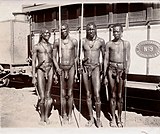 Four Masai tribesmen, (c. 1900)
Four Masai tribesmen, (c. 1900)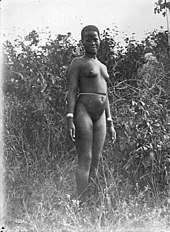 Indigenous woman in German East Africa, early 20th century
Indigenous woman in German East Africa, early 20th century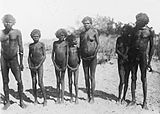 Aboriginal people at Cape Dombey, north of Port Keats, Northern Territory (1905)
Aboriginal people at Cape Dombey, north of Port Keats, Northern Territory (1905)_(14769808302).jpg) Fijian girl (1908). The locks of hair falling on her right shoulder show that she is unmarried. When she weds they will be cut.
Fijian girl (1908). The locks of hair falling on her right shoulder show that she is unmarried. When she weds they will be cut.
General issues
Child development
The National Child Traumatic Stress Network issued a report in 2009 on child sexual development in the United States. The report asserted that children have a natural curiosity about their own bodies and the bodies of others that ought to be addressed in an age-appropriate manner. According to the report:
- Children less than four years old will normally touch their own private parts, look at the private parts of others, and remove their clothes wanting to be naked;
- Between ages four and six, children will be more actively curious. They will attempt to see others dressing or undressing, or will perhaps "play doctor";
- Between ages six and twelve, children will expand their curiosity to images of undressed people available in the media. They will develop a need for privacy regarding their own bodies and begin to be sexually attracted to peers.
The report recommended that parents learn what is normal in regard to nudity and sexuality at each stage of a child's development and refrain from overreacting to their children's nudity-related behaviors unless there are signs of a problem (e.g. anxiety, aggression, or sexual interactions between children not of the same age or stage of development).[56]
The naturist/nudist point of view is that children are "nudists at heart" and that naturism provides the ideal environment for healthy development. It is noted that modern psychology generally agrees that children can benefit from an open environment where the bodies of others their own age of both sexes are not a mystery. However, there is less agreement regarding children and adults being nude. While some doctors have taken the view that some exposure of children to adult nudity (particularly parental nudity) may be healthy, others—notably Benjamin Spock—disagreed. Spock's view was later attributed to the lingering effect of Freudianism on the medical profession.[57]
In their 1986 study on the effects of social nudity on children, Smith and Sparks concluded that "the viewing of the unclothed body, far from being destructive to the psyche, seems to be either benign or to actually provide positive benefits to the individuals involved.[58] In 1995, Gordon and Schroeder contended that "there is nothing inherently wrong with bathing with children or otherwise appearing naked in front of them", noting that doing so may provide an opportunity for parents to provide important information. They noted that by ages five to six, children begin to develop a sense of modesty, and recommended to parents who desire to be sensitive to their children's wishes that they respect a child's modesty from that age onwards.[59]
In a 1995 review of the literature, Paul Okami concluded that there was no reliable evidence linking exposure to parental nudity to any negative effect.[60] Three years later, his team finished an 18-year longitudinal study that showed that, if anything, such exposure was associated with slight beneficial effects, particularly for boys.[61]
In 1999, psychologist Barbara Bonner recommended against nudity in the home if children exhibit sexual play of a type that is considered problematic.[62] In 2019, psychiatrist Lea Lis recommended that parents allow nudity as a natural part of family life when children are very young, but to respect the modesty that is likely to emerge with puberty.[63]
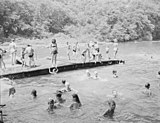 Recreational swim in the Greenbrier River, West Virginia (1946)
Recreational swim in the Greenbrier River, West Virginia (1946)- Fountain in Israel (between 1947 and 1950)
 Bathing in the center of Berlin, East Germany (1958)
Bathing in the center of Berlin, East Germany (1958) A nude family at Lake Senftenberg in East Germany (1980s)
A nude family at Lake Senftenberg in East Germany (1980s)
Cultural differences
Historically in Western societies, there are two cultural traditions relating to nudity in various contexts. The first tradition comes from the ancient Greeks, who saw the naked body as the natural state and as essentially positive. The second is based upon the Abrahamic religions—Judaism, Christianity, and Islam—which have viewed being naked as shameful and essentially negative. The fundamental teachings of these religions prohibit public and sometimes also private nudity. The interaction between the Greek classical and later Abrahamic traditions has resulted in Western ambivalence, with nudity acquiring both positive and negative meanings in individual psychology, in social life, and in depictions such as art. [64] While public modesty prevails In more recent times, organized groups of nudists or naturists emerged with the stated purpose of regaining a natural connection to the human body and nature, sometimes in private spaces but also in public. Naturism in the United States, meanwhile, remains largely confined to private facilities, with few "clothing optional" public spaces compared to Europe. In spite of the liberalization of attitudes toward sex, Americans remain uncomfortable with complete nudity.[65]
In Africa, there is a sharp contrast between the attitude toward nudity in Islamic countries and the attitude toward nudity in certain sub-Saharan countries that never abandoned, or are reasserting, precolonial norms.
In Asia, the norms regarding public nudity are in keeping with the cultural values of social propriety and human dignity. Rather than being perceived as immoral or shameful, nakedness is perceived as a breach of etiquette and perhaps as an embarrassment. In China, saving face is a powerful social force. In Japan, proper behavior included a tradition of mixed gender public baths before Western contact began in the 19th century, and proper attire for farmers and other workers might be a loincloth for both men and women. In India, the conventions regarding proper dress do not apply to monks in some Hindu and Jain sects who reject clothing as worldly.
The encounter between the indigenous cultures of Africa and the Americas with Europeans had a significant effect on both cultures.[66] Western ambivalence could be expressed by responding to the nakedness of natives as either a sign of rampant sexuality or of the innocence that preceded the Fall.[67]
Openness to nudity and sexuality
France, Norway, the Netherlands and the United States show a broad range of openness toward nudity and sexuality as indicated by childhood experiences and sex education practices.
Tous à Poil (Everybody Gets Naked) is a French illustrated book that seeks to address the curiosity of children by providing images of "Real bodies in natural situations from a child’s everyday life to counter the numerous images of bodies... altered by Photoshop or plastic surgery, that are shown in ads or on the covers of magazines." The response from right wing French politicians was that the book is immoral, and claimed that liberal politicians had place the book on school reading lists, which was not true. The Culture Minister defended the book's being available for parents, and supported libraries that were under attack.[68]
As part of a science program on Norwegian public television (NRK), a series on puberty intended for 8–12 year olds includes explicit information and images of reproduction, anatomy, and the changes that are normal with the approach of puberty. Rather than diagrams or photos, the videos are shot in a locker room with live nude people of all ages. The presenter, a physician, is relaxed about close examination and touching of relevant body parts, including genitals. While the videos note that the age of consent in Norway is 16, abstinence is not emphasized. In a subsequent series for teens and young adults, real people were recruited to have sex on tv as counterbalance to the unrealistic presentations in advertising and porn.[69]
As of 2015, however, 37 U.S. states required that sex education curricula include lessons on abstinence and 25 required that a “just say no” approach be stressed. Studies show that early and complete sex education does not increase the likelihood of becoming sexually active, but leads to better health outcomes overall.[70] The Netherlands also has open and comprehensive sex education beginning as early as age 4, which similar health outcomes, in addition to promoting social benefits such as gender equality. Young children often play outdoors or in public wading pools nude.[71]
In a 2018 survey of predominantly white middle-class college students in the United States, only 9.98% of women and 7.04% of men reported seeing real people (either adults or other children) as their first childhood experience of nudity. Many were accidental (walking in on someone) and were more likely to be remembered as negative by women. Only 4.72% of women and 2% of men reported seeing nude images as part of sex education. 83.59% of women and 89.45% of men reported that their first image of nudity was in film, video, or other mass media.[72]
High and low context cultures
High and low context cultures were defined by Edward T. Hall. The behaviors and norms of a high context culture depend upon shared implicit intuitions that operate within a social situation, while in a low context culture behavior is more dependent upon explicit communications.[73] An example of this distinction was found in research on the behavior of French and German naturists on a nude beach. Germans are extremely low in cultural context. They are characterized by individualism, alienation, estrangement from other people, little body contact, low sensitivity to nonverbal cues, and segmentation of time and space. By contrast, the French, in their personal lives are relatively high context: they interact within closely knit groups, are sensitive to nonverbal cues, and engage in relatively high amounts of body contact. To maintain public propriety on a nude beach, German naturists avoided touching themselves and others and avoid any adornments or behaviors that would call attention to the body. French naturists, on the other hand, were more likely than Germans to wear make-up and jewelry and to touch others as they would while dressed.[74]
Concepts of privacy
Societies in continental Europe conceive of privacy as protecting a right to respect and personal dignity. In America, the right to privacy is oriented toward values of liberty, especially in one's home. While Europeans maintain their dignity, even while naked where others may see them, Americans see public nakedness as a surrender of "any reasonable expectation of privacy". Such cultural differences may make some laws and behaviors of other societies seem incomprehensible.[75]
Gender differences
In Western cultures, shame can result from not living up to the ideals of society with regard to physical appearance. Historically, such shame has affected women more than men. With regard to their naked bodies, the result is a tendency towards self-criticism by women, while men are less concerned by the evaluation of others.[76]
In much of the world, the modesty of women is a matter not only of social custom but of the legal definition of indecent exposure. In the United States, the exposure of female nipples is a criminal offense in many states and is not usually allowed in public.[77]
The "topfreedom" movement promotes equal rights for women to be naked above the waist in public on the same basis that would apply to men in the same circumstances.[78]
Breastfeeding in public is forbidden in some jurisdictions, not regulated in others, and protected as a legal right in public and the workplace in still others. Where public breastfeeding is a legal right, some mothers may be reluctant to breastfeed,[79][80] and some people may object to the practice.[81]
Imposed nudity

Punishment
In some situations, nudity is forced on a person. For example, imposed nudity (full or partial) can be part of a corporal punishment or as humiliation, especially when administered in public. For example, in 2017, students at a girls' school in the north-east Indian state of Arunachal Pradesh were forced to undress as a form of punishment, police say. Although not as common as corporal punishment, it is not unusual for stripping to be used as a form of punishment in Indian schools.[82]
Torture
Nazis used forced nudity to attempt to humiliate inmates in concentration camps. This practice was depicted in the film Schindler's List (1994).[83]
In 2003, Abu Ghraib prison in Baghdad (Iraq) gained international notoriety for accounts of torture and abuses by members of the United States Army Reserve during the post-invasion period. Photographic images were circulated that showed the posing of prisoners naked, sometimes bound, and being intimidated and otherwise humiliated, resulting in widespread condemnation of the abuse.[84][85]
Strip search
A strip search is the removal of some or all of a person's clothing to ensure that they do not have weapons or contraband. Such searches are generally done when an individual is imprisoned after an arrest, and is justified by the need to maintain order in the facility, not as punishment for a crime.[86]
Laws regarding public nudity
Since regulation of everyday public behavior is more often a matter of social convention than written law, some jurisdictions may have no specific law against nudity in public. This was the case in 2006, when three young men who had been skinny-dipping outside Brattleboro, Vermont decided to go into town to see what would happen if they disrobed there. They were not arrested, and the following two summers saw a number of incidents of public nakedness until an ordinance banning nudity was passed.[87]
In the 21st century United States, the legal definition of "full nudity" is exposure of the genitals. "Partial nudity" includes exposure of the buttocks by either sex or exposure of the female breasts.[88] Legal definitions are further complicated by laws regarding indecent exposure; this term generally refers to engaging in public nudity with an intent to offend common decency.[89] Lewd and indecent behavior is usually defined as causing alarm, discomfort, or annoyance for the average person. Where the law has been challenged by asserting that nudity by itself in not lewd or disorderly, laws have been amended to specify indecent exposure, usually of the genitals but not always of the breast. Public indecency in generally a misdemeanor, but may become a felony upon repeated offense or always if done in the presence of a minor.[90] In the State of Oregon, public nudity is legal and protected as free speech as long as there is not an "intent to arouse".[91] At the other extreme, the State of Arkansas not only outlaws private nudism, but bans anyone from advocating the practice.[92]
In the United Kingdom, nudity may not be used to "harass, alarm or distress" according to the Public Order Act of 1986.[93] According to a police spokesperson in 2013, nudity per se is not unlawful in the United Kingdom; however, the circumstances surrounding particular episodes of nudity may create public order offenses. Most naturists comply with the law by being nude only where others cannot see them.[94] After repeated arrests, prosecutions, and convictions in Great Britain, the activist Stephen Gough sued at the European Court of Human Rights for the right to be nude in public outside of designated areas. His claim was ultimately rejected.[95]
The brief, sudden exposure of parts of the body normally hidden from public view has a long tradition, taking several forms, which may or may not prompt legal action.
- Flashing refers to the brief public exposure of the genitals or female breasts.[96] At Mardi Gras in New Orleans flashing—an activity that would be prohibited at any other time and place—has become a ritual of long standing in celebration of carnival. While many celebrations of carnival worldwide include minimal costumes, the extent of nudity in the French Quarter is due to its long history as a "red light district". The ritual "disrobing" is done in the context of a performance which earns a payment, even though it is only symbolic (glass beads). Although the majority of those performing continue to be women, men (both homosexual and heterosexual) now also participate.[97]
- Mooning refers to exposure of the buttocks. Mooning opponents in sports or in battle as an insult may have a history going back to ancient Rome.[98]
- Streaking refers to running nude through a public area for publicity, as a prank, as a dare, or as a form of protest.[99]
Morality
Shame is one of the moral emotions often associated with nudity. While guilt is the emotion experienced in response to a particular wrong action, shame is a more general and long-lasting self-assessment.[100] Shame is often thought of as positive in response to a failure to act in accordance with moral values, thus motivating an individual to do better in the future. However, shame is often negative as the response to perceived failures to live up to unrealistic expectations. The shame regarding nudity is one of the classic examples of the emotion, yet rather than being a positive motivator, it is considered unhealthy, standing in the way of developing a positive self-image.[101] Others argue that the shame felt when naked in public is due to valuing modesty and privacy as socially positive.[102] However, the response to such public exposure of normally private behavior is called embarrassment (like guilt, also a short-term emotion), rather than shame.[103]
The moral ambiguity of nudity is reflected in its many meanings, often expressed in the metaphors used to describe cultural values, both positive and negative.[104]
One of the first—but now obsolete—meanings of nude in the 16th century was "mere, plain, open, explicit" reflected in the modern metaphors "the naked truth", "the bare facts". Naturists often speak of their nakedness in terms of a return to the innocence and simplicity of childhood. The term naturism is based upon nakedness as being connected to nature in a positive way; which includes egalitarianism, that all humans are alike in their nakedness. Nudity also represents freedom; the liberation of the body is associated with sexual liberation, although many naturists tend to downplay this connection. In some forms of group psychotherapy, nudity has been used to promote open interaction and communication. Religious persons who reject the world as it is including all possessions may practice nudism, or use nakedness as a protest against an unjust world.[105]
Many of the negative associations are the inverse of positive ones. If nudity is truth, nakedness may be an invasion of privacy or the exposure of uncomfortable truths, a source of anxiety. The strong connection of nudity to sex produces shame when naked in contexts where sexuality is deemed inappropriate. Rather than being natural, nakedness is associated with savagery, poverty, criminality, and death. To be deprived of clothes is punishment; humiliating and degrading.[106]
Confronted with this ambiguity, some individuals seek to resolve it by working toward greater acceptance of nudity for themselves and others. The majority of naturists go through stages during which they gradually learn a new set of values regarding the human body.[107] However, Krista Thomason notes that negative emotions including shame exist because they are functional, and that human beings are not perfect.[108]
Protests
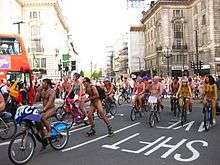
Nudity is used to draw public and attention to a cause, sometimes including the promotion of public nudity itself.[109]
Particular issues represented include animal rights by the group PETA, environmental issues by the World Naked Bike Ride, women's rights by the organization FEMEN.
Sexuality
Persons who practice and advocate personal and social nudity distinguish between sexual and non-sexual nudity. Studies of naturism find that its practitioners adopt behaviors and norms that suppress the sexual responses while practicing social nudity.[110] Such norms include refraining from staring, touching, or otherwise calling attention to the body while naked.[111] However, some naturists do not maintain this non-sexual atmosphere, as when nudist resorts host sexually oriented events.[112]
Modern social practices
Norms related to nudity are associated with norms regarding personal freedom, human sexuality, and gender roles, which vary widely among modern societies. Situations where nudity is accepted vary. Some people practice nudism within the confines of "nudist camps" or clothing-optional resorts, while naturists seek more open acceptance of nudity in everyday life and in public spaces.[113]
Travel writer Rick Steves, who is partially of Norwegian descent, addresses the contrast between the general attitude toward nudity in American and Northern Europe. He notes that in Norway not only is there nakedness in parks and beaches, and more nudity in the media, but more relaxed behavior in other situations, such as medical exams.[114]
Baths and spas
Bathing for cleanliness and recreation is a human universal, and the communal use of bathing facilities has been maintained in many cultures from varying traditional sources. When there is complete nudity, the facilities are often segregated by sex, but not always.
The sauna, originating from Finland, is attended nude in its source country[115] as well as in most Scandinavian countries and in the German-speaking countries of Europe.[116] This is true even when a swimsuit must be worn in the swimming pool area of the same complex.[115] The trend in some European countries (Germany, Finland and the Netherlands, for instance) is to allow both genders to bathe together naked. For example, the Friedrichsbad in Baden-Baden has designated times when mixed nude bathing is permitted. Most German (not to mention French, Spanish and Greek) beaches and swimming pools offer FKK (clothing-optional) areas. The German sauna culture also became popular in neighbouring countries such as Switzerland, Belgium, the Netherlands and Luxembourg.[lower-alpha 1] In contrast to Scandinavia, public sauna facilities in these countries—while nude—do not usually segregate genders.[lower-alpha 2][117]
In Japan, public baths (Sentō) were once common, but became less so with the addition of bathtubs in homes. Sentō were mixed gender (konyoku) until the arrival of Western influences,[33] but became segregated by gender in cities.[118] Nudity is required at Japanese hot spring resorts (Onsen).[119] Some such resorts continue to be mixed gender, but the number of such resorts is declining as they cease to be supported by local communities.[33]
In Korea, bathhouses are known as Jjimjilbang. Such facilities may include mixed-sex sauna areas where clothing is worn, but bathing areas are gender segregated; nudity is required in those areas.[120][119] Korean spas have opened in the United States, also gender separated except the bathing areas. In addition to the health benefits, a woman wrote in Psychology Today suggesting the social benefits for women and girls having real life experience of seeing the variety of real female bodies—even more naked than at a beach—as a counterbalance to the unrealistic nudity seen in popular media.[121]
In Russia, public banyas are clothing-optional and are usually gender-segregated.[119]
Non-Western societies
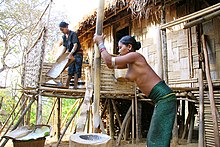
Indigenous traditions
In India, priests of the Digambara ("skyclad") sect of Jainism and some Hindu Sadhus refrain from wearing clothing to symbolize their rejection of the material world.[122][123] In Bangladesh, the Mru people have resisted centuries of Muslim and Christian pressure to cloth their nakedness as part of religious conversion. Most retain their own religion, which includes elements of Buddhism and Animism; as well as traditional clothing, a loincloth for men and a skirt for women.[124]
In sub-Saharan Africa, full nudity or nudity below the waist is the norm among some ethnic and family groups—including some Burkinabese and Nilo-Saharan (e.g. Nuba and Surma people)—in daily life or on particular occasions. For example, at highly attended stick-fighting tournaments, well-exposed young men use the occasion to catch the eye of prospective brides.[125] The revival of post-colonial culture is asserted in the adoption of traditional dress—young women wearing only beaded skirts and jewelry—in the Umkhosi Womhlanga (Reed Dance) by the Zulu and Swazi.[55] However, the authenticity and propriety of the paid performance of "bare chested" Zulu girls for international tourists is sometimes questioned.[126]
In Brazil, the Yawalapiti—an indigenous Xingu tribe in the Amazon Basin—practice a funeral ritual known as Quarup to celebrate life, death and rebirth. The ritual involves the presentation of all young girls who have begun menstruating since the last Quarup and whose time has come to choose a partner.[127]
Clothing optional recreation
Nudity in Asia is generally limited to very isolated locations or private resorts.
Western societies
Private nudity
A 1999 survey by the Federation of Canadian Naturists found that 39% of Canadians "have walked or would walk around their houses nude".[128] According to a 2004 U.S. survey, 31% of men and 14% of women report sleeping in the nude,[129] while a 1996 BBC survey reported that 47% of U.K. men and 17% of U.K. women have done so.[130] In a 2019 survey of American sleep habits, only 17% of respondents stated that they slept entirely naked.[131]
Nudity in semi-public facilities
Historically, certain facilities associated with activities that require partial or complete nakedness, such as bathing or changing clothes, have limited access to certain members of the public. These normal activities are guided by generally accepted norms, the first of which is that the facilities are most often segregated by gender; however, this may not be the case in all cultures.
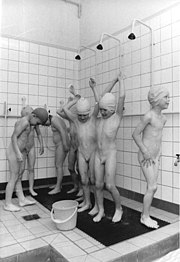
Changing rooms may be provided in stores, workplaces, or sports facilities to allow people to change their clothing. Some changing rooms have individual cubicles or stalls affording varying degrees of privacy. Locker rooms and communal showers associated with sports generally lacked any individual space, thus providing minimal physical privacy.
The men’s locker room—which historically in Western cultures had been a setting for open male social nudity—is, in the 21st century United States, becoming a space of modesty and distancing between men. For much of the 20th century, the norm in locker rooms had been for men to undress completely without embarrassment. That norm has changed; in the 21st century, men typically wear towels or other garments in the locker room most of the time and avoid any interaction with others while naked. This shift is the result of changes in social norms regarding masculinity and how maleness is publicly expressed; also, open male nudity has become associated with homosexuality.[132] In facilities such as the YMCA that cater to multiple generations, the young are uncomfortable sharing space with older people who do not cover up.[133] The behavior in women's locker rooms and showers also indicates a generational change, younger women covering more, and full nudity being brief and rare, while older women are more open and casual.[134]
By the 1990s, communal showers in American schools had become "uncomfortable", not only because students were accustomed to more privacy at home, but because young people became more self-conscious based upon the comparison to mass media images of perfect bodies.[135] In the 21st century, some high-end New York City gyms were redesigned to cater to millennials who want to shower without ever being seen naked.[136] The trend for privacy is being extended to public schools, colleges and community facilities replacing "gang showers" and open locker rooms with individual stalls and changing rooms. The change also addresses issues of transgender usage and family use when one parent accompanies children of differing gender.[137]
This shift in attitudes has come to societies historically open to nudity. In Denmark, secondary school students are now avoiding showering after gym classes. In interviews, students cited the lack of privacy, fears of being judged by idealized standards, and the possibility of being photographed while naked.[138] Similar results were found in schools in Norway.[139]
Social and public nudity

Attitudes toward public nudity vary depending on culture, time, location, and context. There are particular contexts in which nudity is tolerated, accepted, or even encouraged in public spaces. In Europe, such contexts include nude beaches, within some intentional communities (such as naturist resorts or clubs) and at special events.
While some European countries (such as Germany, for example) are rather tolerant of public nudity,[140] other nations disfavor or punish public nudity. In the United States in 2012, the city council of San Francisco, California banned public nudity in the inner-city area. This move was met by harsh resistance because the city was known for its liberal culture and had previously tolerated public nudity.[141][142] Similarly, park rangers began filing tickets against nudists at San Onofre State Beach—also a place with long tradition of public nudity—in 2010.[143]
Naturism
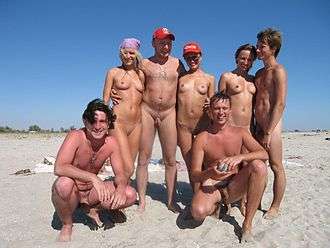
Naturism (or nudism) is a subculture advocating and defending private and public nudity as part of a simple, natural lifestyle. Nudism originated in opposition to the industrialization of Europe in the late 19th century.[144]
Naturists reject contemporary standards of modesty that discourage personal, family and social nudity. They instead seek to create a social environment where individuals feel comfortable being in the company of nude people and being seen nude, either by other naturists or by the general public.[145] In contradiction of the popular belief that nudists are more sexually permissive, research finds that nudist and non-nudists do not differ in their sexual behavior.[146]
Nudism spawned a proselytizing literature in the 1920s and 1930s. Nudism's other common name, naturism, signals its core contention that the naked body is natural and that modesty and shame are cultural impositions with deleterious effects on psychological, sexual, and social well-being. Early nudism was in dialogue with sexology and feminism in a critique of society and its future.[147] While Christian moralists tended to condemn nudism, other Christians argued for the purity of the nude body compared to the corruption of the scanty clothing of the era.[148] Its proponents believed that nudism could combat social inequality, including sexual inequality.[149] As a socially marginal practice based on the naturalness of nakedness, nudism has had a complicated relationship with sexuality and pro‐sex discourses.[150]
The social sciences until the middle of the 20th century often studied public nakedness, including naturism, in the context of deviance or criminality.[151] However, more recent studies find that naturism has positive effects on body image, self esteem and life satisfaction.[152] The Encyclopedia of Social Deviance continues to have an entry on "Nudism",[153] but also defines "Normal Deviance" as violating social norms in a positive way, leading to social change.[154]
Nude beaches
A nude beach, sometimes called a clothing-optional or free beach, is a beach where users are at liberty to be nude. Such beaches are usually on public lands. Nude beaches may be official (legally sanctioned), unofficial (tolerated by residents and law enforcement), or illegal but so isolated as to escape enforcement.
Arts-related activities
Distinct from the nude artworks created, sessions where artists, both amateur and professional, work from live models are a social situation where nudity has a long tradition. The role of the model both as part of visual art education and in the creation of finished works has evolved since antiquity in Western societies and worldwide wherever western cultural practices in the visual arts have been adopted. At modern universities, art schools, and community groups "art model" is a job, one requirement of which is to pose "undraped" and motionless for minutes, hours (with breaks) or days as the artwork requires.[155]
Photography of groups of nude people in public places has been done around the world with or without official cooperation. The gathering itself is proposed as performance art, while the resulting images become statements based upon the identities of people invited to participate by posing, and the location selected; urban, scenic landscapes, or sites of historical significance. The photographers state a variety of artistic, cultural, and political reasons for their work, while those being photographed may be professional models or unpaid volunteers attracted to the project for personal reasons.
- Spencer Tunick has been photographing his "installations" since 1994, often in urban spaces but also in landscapes. The number of participants has also varied, growing from hundreds to thousands of volunteers.[156]
- San Francisco Bay area photographer Jack Gescheidt[157] stages events as part of an ongoing series, called "The Tree Spirit Project".[158]
- Photographer Henning von Berg photographs naked people in public urban locations around the globe.[159] One of the locations was the Reichstag building in Berlin.[160]
Depictions of nudity
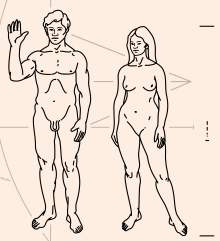
In a picture-making civilization, pictorial conventions continually reaffirm what is natural in human appearance, which is part of socialization.[161]
In Western societies, the contexts for depictions of nudity include information, art and pornography. Any ambiguous image not easily fitting into one of these categories may be misinterpreted, leading to disputes.[162] The nude in photography includes scientific, commercial, fine art, and erotic photography.[163]
Indecency and obscenity
Limits of the depiction of nudity are based upon the legal definitions of indecency and obscenity. In 1973, the Supreme Court in Miller v. California established the three-tiered Miller test to determine what was obscene (and thus not protected) versus what was merely erotic and thus protected by the First Amendment.[163]
Depictions of child nudity (or of children with nude adults) appear in works of art in various cultures and historical periods. These attitudes have changed over time and have become increasingly frowned upon,[164] especially in the case of photography. In recent years, snapshots taken by parents of their nude infant or toddler children were challenged as child pornography.[165]

Art
The nude human figure has been one of the subjects of art from its Paleolithic beginnings, and a major preoccupation of Western art since the ancient Greeks. In "The Nude: a Study in Ideal Form", Lord Kenneth Clark states that to be naked is to be deprived of clothes, and implies embarrassment and shame, while a nude, as a work of art, has no such connotations.[166] This separation of the artistic form from the related social and cultural issues was largely unexamined by classical art historians, but became a focus of social and feminist critiques in the 1970s, when classical nudes of women were seen as symbolic of male objectification of female bodies.[167][168] The debate over objectification has continued, recently energized by the #MeToo movement.[169] An alternative response in England has been the sponsorship of nude modeling and drawing as a means of expressing body positivity.[170]
Performance
Nudity may be used as a part of live performances, such as dance, theater, performance art and nude body painting.
Dance
Dance, as a sequence of human movement, may be ceremonial, social or one of the performing arts. Partial or complete nudity is a feature of ceremonial dances in some tropical countries. However, some claim that modern practices may be used to promote "ethnic tourism" rather than to revive authentic traditions.[171] In Western traditions, dance costumes have evolved towards providing more freedom of movement and revealing more of the body; complete nakedness is the culmination of this process.[172] Modern choreographers consider nudity one of the possible "costumes" available for dance, some seeing nudity as expressing deeper human qualities through dance which works against the sexual objectification of the body in commercial culture.[173] While nudity in social dance is not common, events such as "Naked Tango" have been held in Germany.[174]
Theater
A well-known performance that included nudity was the Broadway musical Hair in 1968.[175] The New York Times printed a number of letters to the editor in 1969 with opinions ranging from actress June Havoc stating that nudity indicates that the producer has run out of ideas; while actress Shelley Winters joked that it was disgusting, but if she were 22 she would do it.[176]
Erotic performances
Models posing on stage nude was a feature of tableaux vivants at London's Windmill Theatre and New York's Ziegfeld Follies in the early 20th century.[177][178] English law did not allow nude actresses to move on stage, but allowed them stand motionless to imitate works of art.[179]
See also
| Wikiquote has quotations related to: Nudity |
References
Notes
- German text: "Dass Männer und Frauen zusammen splitternackt schwitzen, ist eine deutsche Spezialität, für die sich nur noch Urlauber aus den Benelux-Staaten, aus Österreich und der Schweiz erwärmen können, vielleicht auch noch Osteuropäer".[117] English translation: "The fact that men and women sweat together stark naked is a German specialty that only tourists from the Benelux countries, Austria and Switzerland can warm to, maybe even Eastern Europeans".
- German text: "In den Fitnesszentren und Kuranstalten wurde das finnische Bad, oft großzügig ausgestaltet zu ganzen Saunalandschaften, zum selbstverständlichen Angebot. Bemerkenswert ist, dass dort heute zumeist auf getrennte Badezeiten für Männer und Frauen verzichtet wird. Nacktheit von Mann und Frau in der Sauna wird hier längst akzeptiert und das hat ein positives soziales Gesamtklima erzeugt, das selbstregulierend – die seltenen Ausnahmen bestätigen die Regel – das Verhalten der Badegäste bestimmt. Verpöhnt ist [...] der Versuch, sich in Badekleidung [...] unter die Nackten zu mischen".[116] English translation: "In the fitness centers and health resorts, the Finnish bath, often designed generously to complete sauna landscapes, was a natural offer. It is noteworthy that today there is usually no separate bathing times for men and women. Nakedness of men and women in the sauna has been accepted for a long time and that has created a positive overall social climate. Self-regulation – the rare exceptions confirm the rule – determines the behavior of the bathers. Pampered is the attempt [...] to mix in bathing clothes among the naked ones".
Citations
-

- Barcan 2004a, Introduction.
- "Nude". Merriam-Webster's Dictionary. Retrieved 13 November 2019.
Synonyms, Adjective: au naturel, bare, bottomless, disrobed, mother-naked, naked, raw, starkers [chiefly British], stripped, unclad, unclothed, undressed; Noun: altogether, bareness, birthday suit, bottomlessness, buff, nakedness, nudity, raw
- Kushlan 1980.
- Wheeler 1985.
- Sutou 2012.
- Daley 2018.
- Jablonski 2012.
- Wade 2003.
- Rantala 2007, pp. 1–7.
- Jablonski & Chaplin 2000, pp. 57–106.
- Jablonski & Chaplin 2017.
- Toups et al. 2010, pp. 29–32.
- Schlebusch 2017.
- Gilligan 2010.
- Hollander 1978, p. 83.
- Leary & Buttermore 2003.
- Batten 2010.
- Mertz 1990, p. 75.
- Mark 2017.
- Altenmüller 1998, pp. 406–7.
- Adams 2005, p. 57.
- Kosso & Scott 2009, pp. 61-86.
- Habinek & Schiesaro 1997, p. 39.
- Cicero 1927, p. 408.
- Fagan 2002.
- "Dress – The Middle East from the 6th Century". Encyclopedia Britannica. Retrieved 21 December 2019.
- Velleman 2001.
- Silverman 2013.
- Livingstone 2013.
- Rasmussen 2013.
- Henry 1999, pp. 475–486.
- Hadfield 2016.
- Martinez 1995.
- Harper 2012.
- Glancy 2015.
- Byrde 1987.
- Lerner 1972.
- Classen 2008.
- Veyne 1987, p. 455.
- "Did people in the Middle Ages take baths?". Medievalists.net. 13 April 2013. Retrieved 27 October 2019.
- Miles & Lyon 2008.
- Lindsay 2005, p. 173.
- Kosso & Scott 2009, pp. 171-190.
- Barcan 2004a, chpt. 2.
- Stevens 2003, pp. 124–140.
- Andrews 2007, pp. 131–156.
- "Modern History Sourcebook: Women Miners in English Coal Pits". Fordham University. Retrieved 9 November 2019.
- Wiltse 2003.
- "Historic Archive – Male Nude Swimming". Historical Archives – Male Nude Swimming. Retrieved 8 November 2019.
- Smithers 1999.
- Senelick 2014.
- Mann 1963.
- Sterba 1974.
- Nkosi 2013.
- Sexual Development and Behavior in Children: Information for Parents and Caregivers (Report). American Psychological Association. 2009. doi:10.1037/e736972011-001.
- Shantz 2017.
- Smith & Sparks 1986, p. 183.
- Gordon & Schroeder 1995, p. 16.
- Okami 1995, pp. 51–64.
- Okami et al. 1998, pp. 361–384.
- Bonner 1999, p. 211.
- Lis 2019.
- Barcan 2004a, p. 7.
- Layng 1998.
- Masquelier 2005, pp. 1-34.
- Masquelier 2005, p. 66.
- Marosevic 2014.
- Steffensen, Louise Older (31 October 2017). "Norway's National Broadcaster Is Asking Couples to Have Sex on TV". Culture Trip. Retrieved 3 April 2020.
- Zadrozny 2015.
- Rough 2018.
- Allen et al. 2018.
- Hall 1989.
- Smith 1980.
- Whitman 2004, p. 9.
- Weinberg & Williams 2010.
- Williams 2019.
- Jensen 2004.
- Wolf 2008, p. 11.
- Vance 2005, pp. 51–54.
- Jordan & Pile 2003, p. 233.
- "Inquiry after India students 'stripped for punishment'". BBC. 30 November 2017. Retrieved 11 November 2019.
- McDonald & Swaak-Goldman 2000, pp. 280–283.
- "CNN.com – Iraq prison 'abuse' sparks outrage". CNN.com. 30 April 2004. Retrieved 8 November 2019.
- Hoge 2004.
- "Strip Search After an Arrest". FindLaw. Retrieved 11 November 2019.
- Anand 2008.
- "Definition of Partial nudity". Law Insider. Retrieved 31 October 2019.
- "Indecent Exposure". Merriam-Webster's Legal Dictionary. Retrieved 12 November 2019.
- Posner & Silbaugh 1996, chpt. 6.
- Hale 2015.
- Posner & Silbaugh 1996, p. 85.
- Arfin 2019.
- "BBC News – Naturism numbers are reportedly up in the heatwave". BBC Online. 18 July 2013. Retrieved 18 July 2013.
A police spokesman told the BBC there is no law against public nudity in the UK. 'Nudity itself is not illegal. However using nudity to harass, alarm or distress others is an offence against the Public Order Act of 1986.'
- Shaw 2014.
- "Definition of Flashing". MedicineNet.
- Shrum & Kilburn 1996.
- Wickman 2012.
- Speirs, Doug (23 June 2018). "Jun 2018: Streakers make some events memorable for wrong reasons". Winnipeg Free Press – via www.winnipegfreepress.com.
- Uebel 2019.
- Thomason 2018, chpt. 1.
- Deonna, Rodogno & Teroni 2012.
- Thomason 2018, p. 11.
- Barcan 2004a, pp. 77–83.
- Barcan 2004a, pp. 83–106.
- Barcan 2004a, pp. 106–138.
- Górnicka 2016.
- Thomason 2018, Conclusion.
- Alaimo 2010.
- Smith & King 2009, pp. 439–446.
- Smith 1980, pp. 223–241.
- Silver 1991.
- Cooper 2011, pp. 326–357.
- Steves n.d.
- Daney 1998.
- Scheuch 2004, pp. 156-.
- Kast 2014.
- "Public Baths in Japan". Japan Guide. Retrieved 31 October 2019.
- Sood 2012.
- Milner 2015.
- Taylor 2012.
- Dundas 2004.
- Hartsuiker 2014.
- Van Schendel 2002.
- "Stick Fight". Omo Valley Tribal Tours. Retrieved 31 October 2019.
- Naidu 2009.
- Hampton 2014, pp. 175–.
- "1999 National Survey on Canadian Attitudes Towards Nudity". Archived from the original on 5 December 2013. Retrieved 18 December 2015.
- The American Sex Survey: A Peek Beneath the Sheets (PDF), abcnews, 21 October 2004, p. 26, retrieved 4 September 2009
- The Clothes Show, BBC, May 1996
- Smith 2019.
- Miller 2016.
- Tosches 2012.
- Goldman 2007.
- Johnson 1996.
- Sicha 2015.
- Steinbach 2017.
- Frydendal & Thing 2020.
- Johansen et al. 2017.
- "Baring It All: Get Naked with the Germans". Spiegel Online. 10 May 2006. Retrieved 13 September 2016.
- Taub 2012.
- Reynolds 2012.
- Sisson 2010.
- "Nudism". Subcultures and Sociology. Retrieved 17 November 2019.
- Hile 2004.
- Story 1987.
- Barcan 2004b, pp. 63-65.
- Barcan 2004b, pp. 65-66.
- Barcan 2004b, pp. 67-68.
- Barcan 2015.
- Barcan 2004a, pp. 4–10.
- West 2018, pp. 677–697.
- Black 2014.
- Hasha & Kalish 2014.
- Steinhart 2004.
- "Spencer Tunick". ArtNet. Retrieved 23 March 2020.
- "Jack Gescheidt photographer". www.jackphoto.com. Retrieved 6 July 2017.
- "TreeSpirit Project – Raising awareness of the critical role of trees in our lives". www.treespiritproject.com. Retrieved 6 July 2017.
- "Henning von Berg: About 2". Henning-von-berg.com. Retrieved 19 December 2019.
- "Henning von Berg: About 1". Henning-von-berg.com. Retrieved 19 December 2019.
- Hollander 1978.
- Eck 2001.
- Rasmus 2011.
- Higonnet 1998.
- Kincaid 2000.
- Clark 1956, chpt. 1.
- Berger 1972.
- Mulvey 1975.
- Slenske & Langmuir 2018.
- "Spirited Bodies - activist life modelling and life drawing". Retrieved 18 May 2020.
- Firenzi 2012.
- Sparshott 1995.
- Cappelle & Whittenburg 2014.
- Nethers 2013.
- Libbey 2018.
- NY Times Editorial 1969.
- Chapman 2018.
- Bloom 2013.
- Jacobs 2012.
Sources
Books
- Altenmüller, Hartwig (1998). Egypt: the world of the pharaohs. Cologne: Könemann.
- Bancroft, John (2003). Sexual Development in Childhood. Indiana University Press. ISBN 978-0-253-34243-0.
- Barcan, Ruth (2004a). Nudity: A Cultural Anatomy. Berg Publishers. ISBN 1859738729.
- Barcan, Ruth (2015). "Nudism". In Patricia Whelehan; Anne Bolin (eds.). The International Encyclopedia of Human Sexuality. Wiley-Blackwell. pp. 819–830. doi:10.1002/9781118896877.wbiehs315. ISBN 9781786842992.
- Berger, John (1972). Ways of Seeing. Penguin. ISBN 0-14-013515-4.
- Black, Pamela (2014). "Nudism". In Forsyth, Craig J.; Copes, Heith (eds.). Encyclopedia of Social Deviance. SAGE Publications. pp. 471–472. ISBN 9781483340463.
- Bloom, Ken (18 October 2013). Routledge Guide to Broadway. Routledge – via Google Books.
- Bonner, Barbara L. (1999). "When does sexual play suggest a problem?". In Dubowitz, Howard; Depanfilis, Diane (eds.). Handbook for Child Protection Practice. Sage Publications. ISBN 978-0-7619-1371-9.
- Bullough, Vern L.; Bullough, Bonnie (2014). Human Sexuality: An Encyclopedia. Routledge. p. 449. ISBN 9781135825096.
- Carr-Gomm, Philip (2010). A Brief History of Nakedness. London, UK: Reaktion Books, Limited. ISBN 978-1-86189-729-9. Retrieved 1 August 2019.
- Cicero (1927). Tusculan Disputations. Loeb Classical Library 141. XVIII. Translated by by J. E. King. doi:10.4159/DLCL.marcus_tullius_cicero-tusculan_disputations.1927.
- Clark, Kenneth (1956). The Nude: A Study in Ideal Form. Princeton: Princeton University Press. ISBN 0-691-01788-3.
- Classen, Albrecht (2008). "The Cultural Significance of Sexuality in the Middle Ages, the Renaissance, and Beyond". In Classen, Albrecht (ed.). Sexuality in the Middle Ages and the Early Modern Times. Berlin: Walter de Gruyter. ISBN 9783110209402.
- Deonna, Julien A.; Rodogno, Raffaele; Teroni, Fabrice (2012). In Defense of Shame: The Faces of an Emotion. Oxford University Press. ISBN 9780199793532.
- Dundas, Paul (2004). The Jains. London: Routledge. doi:10.4324/9780203398272. ISBN 9780203398272.
- Fagan, Garrett G. (2002). Bathing in Public in the Roman World. University of Michigan Press. ISBN 0472088653.
- Fallon, L. Fleming; Davidson, Tish (2012). "Voyeurism". In Key, Kristin (ed.). The Gale Encyclopedia of Mental Health. 2 (3rd ed.). Detroit, MI: Gale. pp. 1642–1644.
- Frey, Rebecca; Willingham, Emily Jane (2012). "Exhibitionism". In Key, Kristin (ed.). The Gale Encyclopedia of Mental Health. 1 (3rd ed.). Detroit, MI: Gale. pp. 598–602.
- Goldman, Leslie (2007). Locker Room Diaries : The Naked Truth about Women, Body Image, and Re-imagining the "Perfect" Body. Cambridge, MA: Da Capo Press. ISBN 9786612788604.
- Gordon, Betty N.; Schroeder, Carolyn S. (1995). Sexuality: A Developmental Approach to Problems. Springer. ISBN 978-0-306-45040-2.
- Górnicka, Barbara (2016). "From Lewd to Nude: Becoming a Naturist". Nakedness, Shame, and Embarrassment. Figurationen. Schriften zur Zivilisations und Prozesstheorie. 12. Wiesbaden: Springer VS.
- Hall, Edward T. (1989). Beyond Culture. New York: Doubleday. pp. 87–88. ISBN 0385124740. OCLC 20595709.
- Habinek, Thomas; Schiesaro, Alessandro (1997). The Roman Cultural Revolution. Cambridge University Press.
- Hampton, Christopher (2014). Christopher Hampton Plays 1: Total Eclipse; The Philanthropist; Savages; Treats. Faber & Faber. ISBN 978-0-571-31830-8.
- Hartsuiker, Dolf (2014). Sadhus: Holy Men of India. Inner Traditions. p. 176. ISBN 978-1620554029.
- Hasha, Margot; Kalish, DeAnn (2014). "Normal Deviance". In Forsyth, Craig J.; Copes, Heith (eds.). Encyclopedia of Social Deviance. SAGE Publications. pp. 467–468. ISBN 9781483340463.
- Higonnet, Anne (1998). Pictures of Innocence – The History and Crisis of Ideal Childhood. New York: Thames & Hudson. ISBN 978-0-500-28048-5. OL 705008M.
- Hollander, Anne (1978). Seeing Through Clothes. New York: Viking Press. ISBN 0140110844.
- Jablonski, Nina G. (2006). Skin: A Natural History. Berkeley: University of California Press. ISBN 9780520954816.
- Jacobs, Steven (27 August 2012). Framing Pictures. Edinburgh University Press – via Google Books.
- Jordan, Tim; Pile, Steve, eds. (2003). Social Change. Wiley. ISBN 978-0-631-23312-1.
- Kosso, Cynthia; Scott, Anne, eds. (2009). The Nature and Function of Water, Baths, Bathing, and Hygiene from Antiquity Through the Renaissance. Boston: Brill. ISBN 978-9004173576.
- Lerner, Robert E. (1972). The Heresy of the Free Spirit in the Later Middle Ages. Berkeley, CA: University of California Press.
- Lindsay, James E. (2005). Daily Life in the Medieval Islamic World. Daily Life through History. Westport, Conn: Greenwood Press.
- Livingstone, E. A., ed. (2013). The Concise Oxford Dictionary of the Christian Church (3 ed.). Oxford University Press. ISBN 9780199659623.
- McDonald, Gabrielle Kirk; Swaak-Goldman, Olivia (2000). Substantive and Procedural Aspects of International Criminal Law: The Experience of International and National Courts: Materials. 2. Brill. ISBN 90-411-1134-4.
- Mark, Joshua J. (27 March 2017). "Fashion and Dress in Ancient Egypt". Ancient History Encyclopedia.
- Martinez, D.P. (1995). "Naked Divers: A Case of Identity and Dress in Japan". In Eicher, Joanne B. (ed.). Dress and Ethnicity: Change Across Space and Time. Ethnicity and Identity Series. Oxford: Berg. p. 79–94. doi:10.2752/9781847881342/DRESSETHN0009. ISBN 9781847881342.
- Masquelier, Adeline Marie (2005). Dirt, Undress, and Difference Critical Perspectives on the Body’s Surface. Bloomington: Indiana University Press.
- Mertz, Barbara (1990). Red Land, Black Land: Daily Life in Ancient Egypt. Peter Bedrick Books. ISBN 9780872262225.
- Miles, Margaret R.; Lyon, Vanessa (2008). A Complex Delight: The Secularization of the Breast, 1350-1750. University of California Press. ISBN 978-0520253483.
- Posner, Richard A.; Silbaugh, Katharine B. (1996). A Guide to America's Sex Laws. University of Chicago Press. ISBN 9780226675640.
- Scheuch, Manfred (2004). Nackt; Kulturgeschichte eines Tabus im 20. Jahrhundert [Nudity: A Cultural History of a taboo in the 20th century] (in German). Vienna: Christian Brandstätter Verlag. ISBN 978-3-85498-289-0.
- Silverman, Eric (2013). A Cultural History of Jewish Dress. A&C Black. ISBN 978-0-857-85209-0.
The Five Books of Moses...clearly specify that Jews must adhere to a particular dress code-modesty, for example, and fringes. Clothing, too, served as a "fence" that protected Jews from the profanities and pollutions of the non-Jewish societies in which they dwelled. From this angle, Jews dressed distinctively as God's elect.
- Smith, Dennis Craig; Sparks, William (1986). The Naked Child: Growing Up Without Shame. Elysium Growth Press. ISBN 978-1-55599-000-8.
- Steinhart, Peter (2004). The Undressed Art: Why We Draw. New York: Alfred A. Knopf. ISBN 978-1-4000-4184-8.
- Stevens, Scott Manning (2003). "New World Contacts and the Trope of the 'Naked Savage". In Elizabeth D. Harvey (ed.). Sensible Flesh: On Touch in Early Modern Culture. University of Pennsylvania Press. pp. 124–140. ISBN 9780812293630.
- Tierney, Tom (1999). Ancient Egyptian Fashions. Mineola, NY: Dover. ISBN 978-0-486-40806-4.
- Toepfer, Karl Eric (1997). Empire of Ecstasy: Nudity and Movement in German Body Culture, 1910-1935. University of California Press. ISBN 9780520918276.
- Thomason, Krista K. (2018). Naked: The Dark Side of Shame and Moral Life. New York: Oxford University Press. doi:10.1093/oso/9780190843274.003.0007.
- Veyne, Paul, ed. (1987). A History of Private Life: From Pagan Rome to Byzantium. A History of Private Life. 1. Cambridge, Mass: Belknap Press of Harvard University Press. ISBN 9780674399747.
Journal articles
- Alaimo, Stacy (2010). "The naked word: The trans-corporeal ethics of the protesting body". Women & Performance: A Journal of Feminist Theory. 20 (1): 15–36. doi:10.1080/07407701003589253. ISSN 0740-770X.
- Allen, Katherine R.; Gary, Emily A.; Lavender-Stott, Erin S.; Kaestle, Christine E. (2018). "'I Walked in on Them': Young Adults' Childhood Perceptions of Sex and Nudity in Family and Public Contexts". Journal of Family Issues. 39 (15): 3804–3831. doi:10.1177/0192513X18793923.
- Andrews, Jonathan (1 June 2007). "The (un)dress of the mad poor in England, c.1650-1850. Part 2" (PDF). History of Psychiatry. 18 (2): 131–156. doi:10.1177/0957154X06067246. ISSN 0957-154X. PMID 18589927.
- Barcan, Ruth (2001). "The Moral Bath of Bodily Unconsciousness: Female Nudism, Bodily Exposure and the Gaze". Continuum. 15 (3): 303–317. doi:10.1080/10304310120086795.
- Barcan, Ruth (2004b). "Regaining what Mankind has Lost through Civilisation: Early Nudism and Ambivalent Moderns". Fashion Theory. 8 (1): 63–82. doi:10.2752/136270404778051870.
- Batten, Alicia J. (2010). "Clothing and Adornment". Biblical Theology Bulletin: Journal of Bible and Culture. 40 (3): 148–59. doi:10.1177/0146107910375547.
- Byrde, Penelope (1987). "'That Frightful Unbecoming Dress' Clothes for Spa Bathing at Bath". Costume. 21 (1): 44–56. doi:10.1179/cos.1987.21.1.44.
- Collard, Mark; Tarle, Lia; Sandgathe, Dennis; Allan, Alexander (2016). "Faunal evidence for a difference in clothing use between Neanderthals and early modern humans in Europe". Journal of Anthropological Archaeology. 44: 235–246. doi:10.1016/j.jaa.2016.07.010. hdl:2164/9989.
- Condra, Mollie B. (1992). "Bare Facts and Naked Truths: Gender, Power, and Freedom of Expression". Free Speech Yearbook. 30: 129–48. doi:10.1080/08997225.1992.10556145.
- Cooper, D. (2011). "Theorising Nudist Equality: An Encounter Between Political Fantasy and Public Appearance" (PDF). Antipode. 43 (2): 326–357. doi:10.1111/j.1467-8330.2010.00833.x.
- Eck, Beth A. (December 2001). "Nudity and Framing: Classifying Art, Pornography, Information, and Ambiguity". Sociological Forum. Springer. 16 (4): 603–632. doi:10.1023/A:1012862311849. JSTOR 684826.
- Emmerink, Peggy M. J.; van den Eijnden1, Regina J. J. M.; Vanwesenbeeck, Ine; ter Bogt, Tom F. M. (2016). "The Relationship Between Endorsement of the Sexual Double Standard and Sexual Cognitions and Emotions". Sex Roles. New York. 75 (7–8): 363–76. doi:10.1007/s11199-016-0616-z. PMC 5023751. PMID 27688527.
- Firenzi, T (2012). "The Changing Functions of Traditional Dance in Zulu Society: 1830–Present". The International Journal of African Historical Studies. 45 (3): 403–425.
- Frydendal, Stine; Thing, Lone Friis (2020). "A Shameful Affair? A Figurational Study of the Change Room and Showering Culture Connected to Physical Education in Danish Upper Secondary Schools". Sport, Education and Society. 25 (2): 161–72. doi:10.1080/13573322.2018.1564654.
- Gilligan, Ian (2010). "The Prehistoric Development of Clothing: Archaeological Implications of a Thermal Model". Journal of Archaeological Method & Theory. 17 (1): 15–80. doi:10.1007/s10816-009-9076-x.
- Glancy, Jennifer A (2015). "The Sexual Use of Slaves: A Response to Kyle Harper on Jewish and Christian Porneia". Journal of Biblical Literature. 134 (1): 215–29. doi:10.1353/jbl.2015.0003.
- Harper, Kyle (2012). "Porneia: The Making of a Christian Sexual Norm". Journal of Biblical Literature. 131 (2): 363–83. doi:10.2307/23488230. JSTOR 23488230.
- Henry, Eric (1999). "The Social Significance of Nudity in Early China". Fashion Theory. 3 (4): 475–486. doi:10.2752/136270499779476036.
- Jablonski, Nina G.; Chaplin, George (2000). "The Evolution of Human Skin Coloration". Journal of Human Evolution. 39 (1): 57–106. doi:10.1006/jhev.2000.0403. PMID 10896812.
- Jablonski, Nina G.; Chaplin, George (2017). "The Colours of Humanity: The Evolution of Pigmentation in the Human Lineage". Philosophical Transactions of the Royal Society B: Biological Sciences. 372 (1724): 20160349. doi:10.1098/rstb.2016.0349. PMC 5444068. PMID 28533464.
- Jensen, Robin (2004). "Topfreedom: A rhetorical analysis of the debate with a bust". Women and Language. Urbana. 27 (1): 68–69.
- Johansen, Bjørn Tore; Mæhle, Martine; Oland, Øyvind; Haugen, Tommy (2017). "Being Together in the Locker Room Is Great, but Showering Together – Just Forget It! - The Janus Face of the Wardrobe Practice in Physical Education". International Journal of Learning, Teaching and Educational Research. 16 (10): 41–57. doi:10.26803/ijlter.16.10.4.
- Kushlan, James A. (1980). "The Evolution of Hairlessness in Man". The American Naturalist. 116 (5): 727–729. doi:10.1086/283663. JSTOR 2460629.
- Leary, Mark R; Buttermore, Nicole R. (2003). "The Evolution of the Human Self: Tracing the Natural History of Self-Awareness". Journal for the Theory of Social Behaviour. 33 (4): 365–404. doi:10.1046/j.1468-5914.2003.00223.x.
- Mann, Channing (1963). "Swimming Classes in Elementary Schools on a City-Wide Basis". Journal of Health, Physical Education, Recreation. 34 (5): 35–36. doi:10.1080/00221473.1963.10621677.
- Miller, Barry (2016). "On the Loss of Nudity in the Men's Locker Room". Psychological Perspectives. 59 (1): 93–108. doi:10.1080/00332925.2016.1134213.
- Mulvey, Laura (1975). "Visual Pleasure and Narrative Cinema". Screen. 16 (3): 6–18. doi:10.1093/screen/16.3.6.
- Naidu, Maheshvari (2009). "'Topless' Tradition for Tourists: Young Zulu Girls in Tourism". Agenda. 23 (79): 38–48. doi:10.1080/10130950.2009.9676222 (inactive 26 May 2020).
- Nkosi, Gugulethu Sebenzile (2013). Umkhosi Womhlanga (Reed Dance) as a tourism enterprise in KwaZulu-Natal: Perceptions, Policies and Practices (PhD). University of Zululand. hdl:10530/1282.
- Okami, Paul (1995). "Childhood exposure to parental nudity, parent‐child co‐sleeping, and "primal scenes": A review of clinical opinion and empirical evidence". Journal of Sex Research. 32 (1): 51–63. doi:10.1080/00224499509551774. ISSN 0022-4499.
- Okami, Paul; Olmstead, Richard; Abramson, Paul R.; Pendleton, Laura (1998). "Early Childhood Exposure to Parental Nudity and Scenes of Parental Sexuality ('Primal Scenes'): An 18-Year Longitudinal Study of Outcome". Archives of Sexual Behavior. 27 (4): 361–384. doi:10.1023/A:1018736109563. ISSN 0004-0002. PMID 9681119.
- Rantala, M. J. (2007). "Evolution of nakedness in Homo sapiens". Journal of Zoology. 273 (1): 1–7. doi:10.1111/j.1469-7998.2007.00295.x.
- Rasmus, Ryen (2011). "The Auto-Authentication of the Page: Purely Written Speech and the Doctrine of Obscenity". William & Mary Bill of Rights Journal. 20.
- Rasmussen, Susan J. (2013). "Re-Casting the Veil: Situated Meanings of Covering". Culture & Psychology. 19 (2): 237–58. doi:10.1177/1354067X13478989.
- Schlebusch; et al. (3 November 2017). "Southern African ancient genomes estimate modern human divergence to 350,000 to 260,000 years ago". Science. 358 (6363): 652–655. Bibcode:2017Sci...358..652S. doi:10.1126/science.aao6266. PMID 28971970.
- Shantz, Mary-Ann (2017). "'Nudists at Heart': Children's Nature and Child Psychology in the Postwar Canadian Nudist Movement". Journal of the History of Childhood and Youth. Baltimore: John Hopkin's University Press. 10 (2): 228–247. doi:10.1353/hcy.2017.0026. ProQuest 1901236165.
- Shrum, Wesley; Kilburn, John (1996). "Ritual Disrobement at Mardi Gras: Ceremonial Exchange and Moral Order". Social Forces. 75 (2): 423–58. doi:10.2307/2580408. JSTOR 2580408.
- Silver, Nina (1991). "The Shame of Being Naked". Off Our Backs. 21 (8): 6–7. JSTOR 20833713.
- Smith, H. W. (1 September 1980). "A Modest Test of Cross-Cultural Differences in Sexual Modesty, Embarrassment and Self-Disclosure". Qualitative Sociology. 3 (3): 223–241. doi:10.1007/BF00987137. ISSN 1573-7837.
- Smith, Glenn; King, Michael (June 2009). "Naturism and sexuality: Broadening our approach to sexual wellbeing". Health & Place. 15 (2): 439–446. doi:10.1016/j.healthplace.2008.08.002. PMID 18926761.
- Sparshott, Francis (1995). "Some aspects of nudity in theatre dance". Dance Chronicle. 18 (2): 303–310. doi:10.1080/01472529508569206.
- Story, Marilyn D. (1987). "A Comparison of Social Nudists and Non-Nudists on Experience with Various Sexual Outlets". The Journal of Sex Research. 23 (2): 197–211.
- Sutou, Shizuyo (2012). "Hairless mutation: a driving force of humanization from a human-ape common ancestor by enforcing upright walking while holding a baby with both hands". Genes to Cells. 17 (4): 264–272. doi:10.1111/j.1365-2443.2012.01592.x. PMC 3510307. PMID 22404045.
- Toups, M. A.; Kitchen, A.; Light, J. E.; Reed, D. L. (2010). "Origin of Clothing Lice Indicates Early Clothing Use by Anatomically Modern Humans in Africa". Molecular Biology and Evolution. 28 (1): 29–32. doi:10.1093/molbev/msq234. ISSN 0737-4038. PMC 3002236. PMID 20823373.
- Uebel, Michael (2019). "Dirty Rotten Shame? The Value and Ethical Functions of Shame". Journal of Humanistic Psychology. 59 (2): 232–51. doi:10.1177/0022167816631398.
- Uhlmann, Eric Luis; Poehlman, T. Andrew; Tannenbaum, David; Bargh, John A. (2011). "Implicit Puritanism in American Moral Cognition". Journal of Experimental Social Psychology. 47 (2): 312–20.
- Van Schendel, Willem (2002). "A Politics of Nudity: Photographs of the 'Naked Mru' of Bangladesh" (PDF). Modern Asian Studies. 36 (2): 34. doi:10.1017/S0026749X02002032.
- Vance, Melissa R. (2005). "Breastfeeding Legislation in the United States: A General Overview and Implications for Helping Mothers". LEAVEN. 41 (3): 51–54. Archived from the original on 31 March 2007.
- Velleman, J. (2001). "The Genesis of Shame". Philosophy and Public Affairs. 30 (1): 27–52. doi:10.1111/j.1088-4963.2001.00027.x.
- Weinberg, Martin S; Williams, Colin J. (2010). "Bare Bodies: Nudity, Gender, and the Looking Glass Body". Sociological Forum. 25 (1): 47–67. doi:10.1111/j.1573-7861.2009.01156.x.
- West, Keon (1 March 2018). "Naked and Unashamed: Investigations and Applications of the Effects of Naturist Activities on Body Image, Self-Esteem, and Life Satisfaction". Journal of Happiness Studies. 19 (3): 677–697. doi:10.1007/s10902-017-9846-1. ISSN 1573-7780.
- Wheeler, P.E. (1985). "The loss of functional body hair in man: the influence of thermal environment, body form and bipedality". Journal of Human Evolution. 14 (14): 23–28. doi:10.1016/S0047-2484(85)80091-9.
- Whitman, James Q. (1 April 2004). "The Two Western Cultures of Privacy: Dignity versus Liberty". The Yale Law Journal. 113 (6): 1151–1221. doi:10.2307/4135723. JSTOR 4135723.
- Wiltse, Jeffrey (2003). "Contested waters: A History of Swimming Pools in America". ProQuest Dissertations & Theses Global. ProQuest 305343056.
- Wolf, JH (2008). "Got milk? Not in public!". International Breastfeeding Journal. 3 (1): 11. doi:10.1186/1746-4358-3-11. PMC 2518137. PMID 18680578.
News
- Adams, Cecil (9 December 2005). "Small Packages". Isthmus; Madison, Wis. Madison, Wis., United States, Madison, Wis. p. 57. ISSN 1081-4043. ProQuest 380968646.
- Anand, Shefali (19 May 2008). "Modest proposal: A Vermont town bucks nakedness; skinny-dipping spurs an outbreak of nudity; the fanny-pack man". Wall Street Journal.
- Andreatta, David (22 September 2017). "When boys swam nude in gym class". Democrat and Chronicle.
- Bridge, A. (5 February 2016). "Germans Most Likely to Go Nude". The Telegraph.
- Cappelle, Laura; Whittenburg, Zachary (1 April 2014). "Baring It All". Dance Magazine.
- Davenport, Justin (17 March 2014). "Met officers subject 4,600 children to strip searches over five years". London Evening Standard. p. 22.
- Grulovic, Tiyana (2014). "Simply the Breast". Flare Toronto. Vol. 36 no. 10 (Oct 2014). pp. 70–71.
- Hale, Jamie (29 June 2015). "Public nudity in Oregon: Where you can and can't legally be naked in the open". The Oregonian.
- Hoge, Warren (4 June 2004). "U.N. Says Abu Ghraib Abuse Could Constitute War Crime". The New York Times. Retrieved 8 November 2019.
- Jablonski, Nina G. (1 November 2012). "The Naked Truth". Scientific American.
- Johnson, Dirk (22 April 1996). "Students Still Sweat, They Just Don't Shower". The New York Times.
- Kast, Günter (18 November 2014). "Bekleidung in der Sauna: Was haben Sie denn an?" [Clothing in the Sauna: What are you wearing]. Frankfurter Allgemeine Zeitung (in German). Retrieved 3 September 2019.
- Layng, Anthony (1998). "Confronting the Public Nudity Taboo". USA Today Magazine. Vol. 126 no. 2634. p. 24.
- Libbey, Peter (29 April 2018). "When 'Hair' Opened on Broadway, It Courted Controversy From the Start". The New York Times. Retrieved 15 November 2019.
- Lis, Lea (5 May 2019). "Eight Things to Know About Nudity and Your Family". Psychology Today. Retrieved 31 July 2019.
- Nethers, Jocelyn (2013). "I Went 'Cause I Had Nothing On...". Dance Today. Vol. 58 no. 146. p. 56.
- NY Times Editorial (22 June 1969). "No Nudity Needed". The New York Times. Retrieved 8 December 2019.
- Okeowo, Alexis (21 March 2011). "The Ivory Coast Effect". The New Yorker. Retrieved 3 September 2019.
- Reynolds, Eoin (20 November 2012). "San Francisco nudists warn of backlash if anti-naked law passes". the Guardian. Retrieved 13 September 2016.
- Riding, Alan (25 September 1995). "The School of London, Mordantly Messy as Ever". The New York Times. Retrieved 16 February 2013.
- Rough, Bonnie J. (27 August 2018). "How the Dutch Do Sex Ed". The Atlantic.
In the Netherlands, one of the world’s most gender-equal countries, kids learn about sex and bodies starting at age 4.
- Senelick, Richard (3 February 2014). "Men, Manliness, and Being Naked Around Other Men". The Atlantic.
- Shaw, Danny (28 October 2014). "Naked rambler Stephen Gough loses human rights case". BBC News. Retrieved 29 September 2016 – via www.bbc.com.
- Sisson, Paul (23 March 2010). "SAN ONOFRE: State begins citing nudists at beach". The San Diego Union-Tribune. Retrieved 13 September 2016.
- Sicha, Choire (3 December 2015). "Men's Locker Room Designers Take Pity on Naked Millennials". The New York Times.
- Slenske, M.; Langmuir, M. (16 April 2018). "Who's Afraid of the Female Nude". New York. ProQuest 2037464739.
- Smithers, Rebecca (21 December 1999). "Curtains for schools' communal showers". The Guardian.
- Sterba, James (3 September 1974). "Nudity Increases in America". The New York Times.
- Taub, Gypsy (23 November 2012). "The naked truth about San Francisco's nudity ban". The Guardian. Retrieved 13 September 2016.
- Tayler, Jeffrey (22 March 2013). "Tunisian Woman Sent to a Psychiatric Hospital for Posting Topless Photos on Facebook". The Atlantic.
- Taylor, Zanthe (28 February 2012). "The (Un-Erotic) Glories of Nudity". Psychology Today.
- Tosches, Rich (5 January 2012). "Long Live the FONG". Colorado Springs Independent. ProQuest 918464360.
- Wade, Nicholas (19 August 2003). "Why Humans and Their Fur Parted Ways". The New York Times.
- Zadrozny, Brandy (14 May 2015). "Are These the World's Most Graphic Sex-Ed Videos?". The Daily Beast.
Websites
- Arfin, Ferne (6 March 2019). "Is Naked Sunbathing Legal in England and Wales?". TripSavvy. Retrieved 3 September 2019.
- Chapman, Helen (20 July 2018). "Windmill Girls meet for reunion and remember dancing days in old Soho". Islington Tribune.
- Conley, Kevin (n.d.). "The Rabble Rousers". Oprah.com. Retrieved 3 September 2019.
- Daley, Jason (11 December 2018). "Why Did Humans Lose Their Fur?". Smithsonian. Retrieved 27 October 2019.
- Daney, Charles (21 January 1998). "Nakedness and the Finnish Sauna". Being and Nakedness. Retrieved 3 September 2019 – via corz.org.
- Ekine, Sokari (2015). "The Curse of Nakedness". Archived from the original on 24 May 2015.
- Eng, Monica (10 September 2017). "Baring It All: Why Boys Swam Naked In Chicago Schools". WBEZ.
- Gardner, Elysa (13 July 2003). "Music videos provocatively skirt the nudity issue". USA Today. Retrieved 11 May 2009.
- Hadfield, James (10 December 2016). "Last splash: Immodest Japanese tradition of mixed bathing may be on the verge of extinction". Japan Times. Retrieved 19 November 2019.
- Hile, Jennifer (2004). "The Skinny on Nudism in the U.S." National Geographic. National Geographic. Retrieved 11 November 2019.
- Kincaid, James R. (31 January 2000). "Is this child pornography?". Salon.com. Archived from the original on 30 April 2007. Retrieved 28 April 2007.
- Lawson, Mark (2 February 2016). "Flashing the flesh – a history of TV nudity". The Guardian. Retrieved 14 November 2019.
- Mapes, Terri (6 March 2019). "Sex and Sexuality in Scandinavia". TripSavvy. Retrieved 7 November 2019.
- Mapes, Terri (3 June 2019). "Nudism in Scandinavia". TripSavvy. Retrieved 7 November 2019.
- Markowitz, Eric (29 April 2014). "Until Fairly Recently, The YMCA Actually Required Swimmers To Be Nude". Vocativ.
- Marosevic, Zeljka (14 February 2014). "Everybody Get Naked, or Don't: Right Wing French Politicians Attack Immoral Children's Books". Melville House Books. Retrieved 22 October 2019.
- Milner, Rebecca (9 July 2015). "First-time jjimjilbang: how to visit a Korean bathhouse". Lonelyplanet.com. Archived from the original on 7 November 2015. Retrieved 23 June 2016.
- Saul, Heather (14 May 2016). "A woman is walking around America bare chested and she wants you to ask her about it". The Independent.
- Sealey, Geraldine (31 July 2002). "Naked Ploy Is Latest Threat in Oil Wars". commondreams.org. Archived from the original on 11 July 2012.
- Smith, Brittany (2019). "Here's the Exact Percentage of People Who Sleep Naked". Men's Journal. Retrieved 11 November 2019.
- Sood, Suemedha (30 November 2012). "The origins of bathhouse culture around the world". BBC Travel. Retrieved 15 November 2019.
- Steves, Rick (n.d.). "Peacefully Progressive Oslo". ricksteves.com. Retrieved 3 July 2020.
- Steinbach, Paul (2017). "Designing Public Locker Rooms with an Eye on Privacy". Athletic Business.
- Weaver, Fran (8 October 2010). "Seeking the real Finnish Sauna". this is FINLAND. Retrieved 7 October 2011.
- Wickman, Forrest (27 June 2012). "Mooning: A History". Slate.com. Retrieved 27 December 2019.
- Williams, Pete (19 August 2019). "Women ask Supreme Court to toss topless ban: Why are rules different for men?". NBC News.
- Zukerman, Wendy (4 November 2011). "Skin 'sees' the light to protect against sunshine". New Scientist. Retrieved 3 September 2019.
